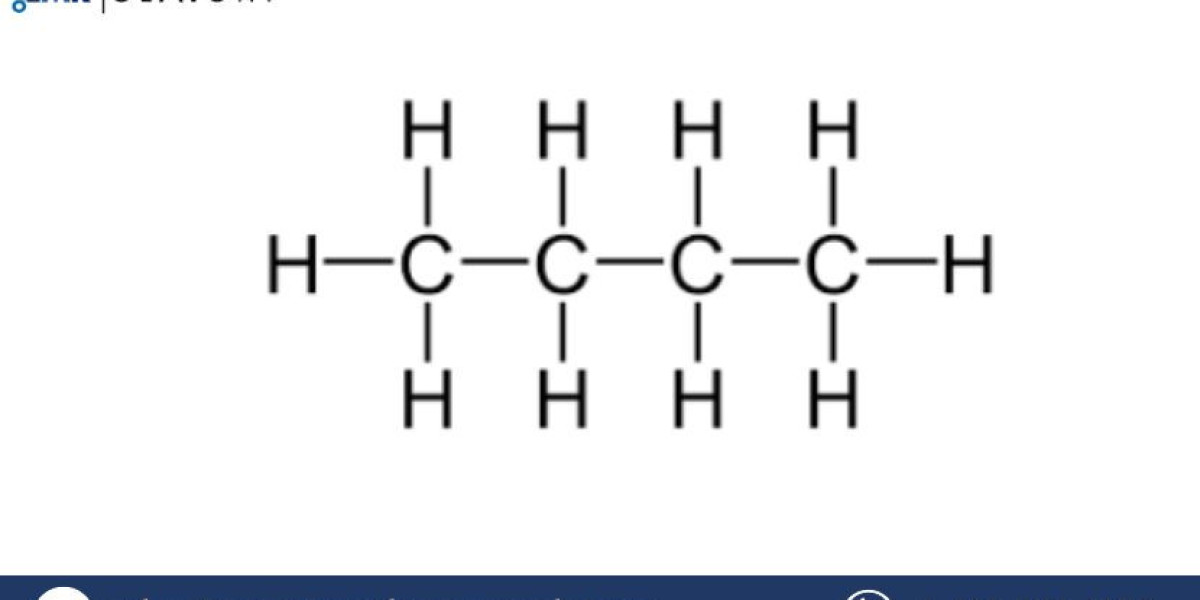Introduction
Butane, a highly versatile hydrocarbon, plays a crucial role in numerous industries due to its wide range of applications. It is primarily used as a fuel, in liquefied petroleum gas (LPG), and as a feedstock in the production of chemicals such as butadiene, isobutene, and other valuable petrochemical products. The global demand for butane is growing, driven by its importance in energy production, automotive fuel, and various chemical processes. This Butane Manufacturing Plant Project Report outlines the steps, raw materials, machinery, infrastructure, market trends, and financial considerations necessary for establishing a butane manufacturing plant.
Overview of Butane
Butane (C4H10) is a colorless, highly flammable gas that is part of the alkane series of hydrocarbons. It is found naturally in petroleum and is often isolated during the refining process. Butane is commonly stored as a liquid under pressure, making it easy to transport and store. It is widely used in the following forms:
- Liquefied Petroleum Gas (LPG): A mixture of propane and butane that is used as a fuel for heating, cooking, and even in vehicles.
- Aerosol Propellant: Used as a propellant in spray cans for products like deodorants, paints, and air fresheners.
- Fuel Additive: Butane is blended with gasoline to improve performance and reduce emissions.
- Chemical Feedstock: Butane is a precursor to various chemicals such as butadiene, isobutene, and synthetic rubber.
Butane's ease of liquefaction and portability make it a preferred fuel source, contributing to its widespread use in homes, vehicles, and industrial applications.
Butane Manufacturing Process
The process of manufacturing butane involves several key stages, starting with the extraction of hydrocarbons from natural sources, followed by refining and separation. The primary method of producing butane is through the refining of crude oil and natural gas. Below is a detailed step-by-step explanation of the butane production process:
1. Raw Material Procurement
The raw materials for butane production are primarily natural gas and crude oil. Butane is often separated from these materials during the refining process, which typically involves a combination of distillation, cracking, and separation techniques.
- Natural Gas: Butane is found in natural gas fields and is separated from methane and other hydrocarbons through a process known as gas processing.
- Crude Oil: In oil refineries, butane is separated during the distillation of crude oil.
Get a Free Sample Report with Table of Contents@
2. Crude Oil Refining
In oil refineries, crude oil is subjected to fractional distillation, which separates it into different hydrocarbon fractions based on their boiling points. Butane is separated in the lighter hydrocarbon fractions, typically in the range of C4 hydrocarbons. The process is as follows:
- Distillation: Crude oil is heated in a distillation column, where it is separated into different components based on boiling points.
- Cracking: Further refinement may involve cracking heavier hydrocarbons to break them down into lighter ones, including butane.
3. Separation and Purification
After butane is separated from other hydrocarbons, it undergoes purification to remove any impurities, including water, sulfur, and heavier hydrocarbons. This is typically done through:
- Absorption: Butane is absorbed in a liquid absorbent to separate it from other gases.
- Fractionation: Butane is further purified through distillation or other separation techniques.
- Drying: Removing any residual moisture from the butane is essential to prevent freezing or clogging when stored in liquid form.
4. Liquefaction and Storage
Butane, which is naturally a gas at room temperature, is typically stored and transported in liquid form by pressurizing it or by cooling it to a low temperature. This is achieved through the use of pressurized storage tanks and cylinders.
- Liquefaction: Butane is compressed and stored as a liquid in pressure vessels.
- Storage Tanks: These tanks are designed to safely hold butane at high pressures, ensuring it remains in its liquid state for ease of transportation and use.
5. Packaging and Distribution
Once the butane is liquefied and stored, it is packaged into cylinders or large tanks for distribution to various industries. These products may include:
- LPG cylinders: For residential, commercial, and industrial use.
- Aerosol Propellant Cans: For consumer products.
- Bulk Distribution: For use in power generation and other industrial applications.
Raw Materials and Inputs Required
The production of butane involves several key raw materials and inputs:
- Crude Oil: The primary source for obtaining butane through the refining process.
- Natural Gas: A secondary source of butane through natural gas processing.
- Energy: Electricity and heat are required to power the refining and separation processes.
- Storage Equipment: Tanks and cylinders for storing and transporting liquid butane.
- Catalysts: In some cases, catalysts may be used in the refining process to improve efficiency and yield.
Machinery and Infrastructure Requirements
The infrastructure and machinery needed to establish a butane manufacturing plant are:
Machinery:
- Distillation Columns: Essential for separating butane from other hydrocarbons.
- Cracking Units: Used to break down heavier hydrocarbons into lighter ones, including butane.
- Absorption Units: For purifying butane by removing impurities.
- Compressor Systems: For liquefying butane by compressing it into its liquid form.
- Storage Tanks: Large, pressure-resistant tanks for storing liquid butane.
- Filling Machines: For filling cylinders and tanks with butane for distribution.
- Quality Control Systems: For ensuring the purity of the final product.
Infrastructure:
- Production Facility: A large factory equipped with necessary machinery for refining, separating, and storing butane.
- Energy Supply: A consistent power source is required to fuel the distillation, cracking, and liquefaction processes.
- Water Supply: Water is needed for cooling and cleaning purposes.
- Safety Systems: Given the flammable nature of butane, safety systems such as gas leak detection, ventilation, fire suppression, and emergency response plans are essential.
Financial Considerations
Initial Investment
Setting up a butane manufacturing plant requires substantial capital investment. The key components of the initial investment include:
- Land and Building: Costs associated with purchasing or leasing land and constructing the manufacturing facility.
- Machinery and Equipment: The costs of distillation units, absorption columns, compressors, storage tanks, and quality control equipment.
- Raw Material Procurement: The initial purchase of crude oil and natural gas for refining and butane extraction.
- Licensing and Permits: Fees for environmental and safety certifications, as well as industry-specific regulations.
- Working Capital: Funds for operational costs, including labor, utilities, and raw materials.
Operating Costs
The ongoing costs to operate a butane manufacturing plant include:
- Raw Materials: Continuous procurement of crude oil, natural gas, and energy.
- Labor: Salaries for workers, supervisors, engineers, and administrative staff.
- Energy Costs: Significant power usage for distillation, cracking, and liquefaction.
- Maintenance: Regular maintenance of machinery and storage equipment.
- Logistics and Distribution: Transportation and storage costs for delivering butane to customers.
Revenue Generation
Revenue is primarily generated by selling butane in various forms:
- LPG (Liquefied Petroleum Gas): Sold in cylinders and tanks for residential, commercial, and industrial use.
- Aerosol Propellant: Sold in aerosol cans for consumer goods.
- Bulk Distribution: For industrial uses such as power generation, heating, and chemical production.
The price of butane can fluctuate based on market conditions, including raw material prices (crude oil and natural gas), demand, and regulatory factors.
Market Demand and Opportunities
The global demand for butane is growing, driven by its widespread use in energy production, petrochemicals, and industrial applications. The major drivers of market demand include:
- LPG Consumption: As a cleaner and more convenient energy source, LPG, which contains butane, is increasingly used for heating, cooking, and automotive fuel in both developing and developed regions.
- Industrial Applications: Butane is used as a feedstock in the production of chemicals such as butadiene and isobutene, which are essential for the manufacturing of synthetic rubber, plastics, and other chemicals.
- Environmental Benefits: Butane is a cleaner-burning fuel compared to coal and other fossil fuels, making it a preferred choice in many regions with strict environmental regulations.
- Emerging Markets: As emerging economies grow and urbanize, the demand for clean cooking fuels and energy sources like LPG is increasing, further boosting the demand for butane.
Media Contact
Company Name: Claight Corporatio
Contact Person: Lewis Fernandas, Corporate Sales Specialist — U.S.A.
Email: sales@expertmarketresearch.com
Toll Free Number: +1–415–325–5166 | +44–702–402–5790
Address: 30 North Gould Street, Sheridan, WY 82801, USA
Website: www.expertmarketresearch.com
Aus Site: https://www.expertmarketresearch.com.au






